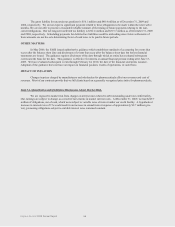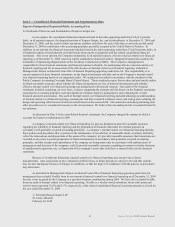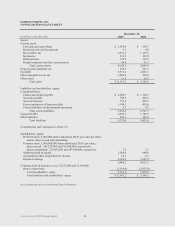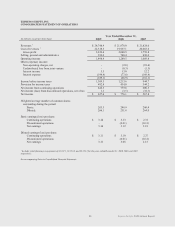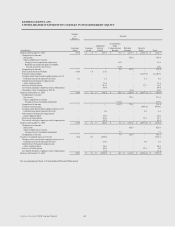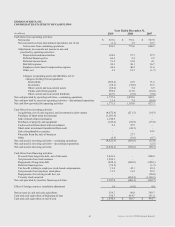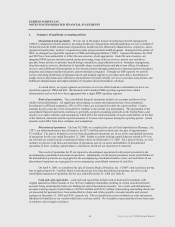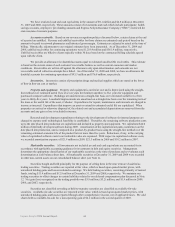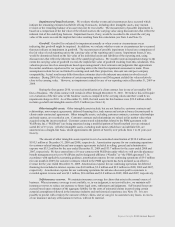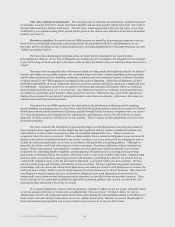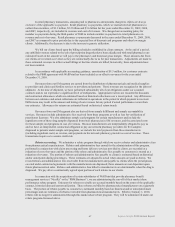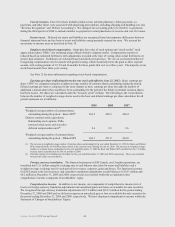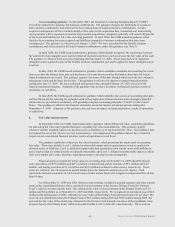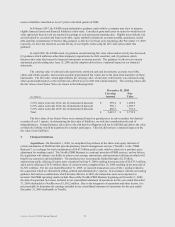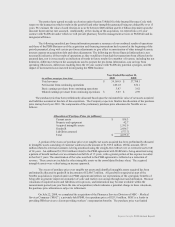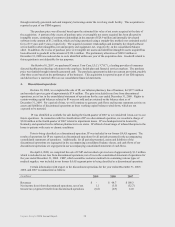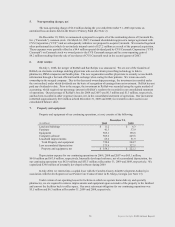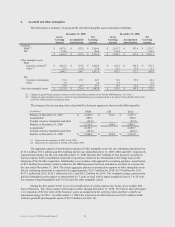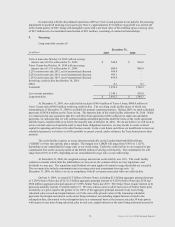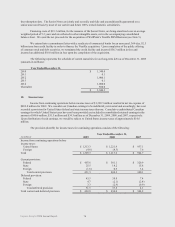Express Scripts 2009 Annual Report Download - page 68
Download and view the complete annual report
Please find page 68 of the 2009 Express Scripts annual report below. You can navigate through the pages in the report by either clicking on the pages listed below, or by using the keyword search tool below to find specific information within the annual report.
Express Scripts 2009 Annual Report 66
Fair value of financial instruments. The carrying value of cash and cash equivalents, restricted cash and
investments, accounts receivable, claims and rebates payable, and accounts payable approximated fair values due to
the short-term maturities of these instruments. The fair value, which approximates the carrying value, of our bank
credit facility was estimated using either quoted market prices or the current rates offered to us for debt with similar
maturity (see Note 2).
Revenue recognition. Revenues from our PBM segment are earned by dispensing prescriptions from our
home delivery and specialty pharmacies, processing claims for prescriptions filled by retail pharmacies in our
networks, and by providing services to drug manufacturers, including administration of discount programs (see also
“Rebate accounting” below).
Revenues from dispensing prescriptions from our home delivery pharmacies are recorded when
prescriptions are shipped. At the time of shipment, our earnings process is complete: the obligation of our customer
to pay for the drugs is fixed, and, due to the nature of the product, the member may not return the drugs nor receive a
refund.
Revenues from our specialty line of business are from providing medications/pharmaceuticals for diseases
that rely upon high-cost injectable, infused, oral, or inhaled drugs which have sensitive handling and storage needs
and bio-pharmaceutical services including marketing, reimbursement and customized logistics solutions. Specialty
revenues earned by our PBM segment are recognized at the point of shipment. At the time of shipment, we have
performed substantially all of our obligations under our customer contracts and do not experience a significant level
of reshipments. Appropriate reserves are recorded for discounts and contractual allowances which are estimated
based on historical collections over a recent period. Any differences between our estimates and actual collections
are reflected in operations in the period in which payment is received. Differences may result in the amount and
timing of our revenues for any period if actual performance varies from our estimates. Allowances for returns are
estimated based on historical return trends.
Revenues from our PBM segment are also derived from the distribution of pharmaceuticals requiring
special handling or packaging where we have been selected by the pharmaceutical manufacturer as part of a limited
distribution network and the distribution of pharmaceuticals through Patient Assistance Programs where we receive
a fee from the pharmaceutical manufacturer for administrative and pharmacy services for the delivery of certain
drugs free of charge to doctors for their low-income patients. These revenues include administrative fees received
from these programs.
Revenues related to the distribution of prescription drugs by retail pharmacies in our networks consist of
the prescription price (ingredient cost plus dispensing fee) negotiated with our clients, including the portion to be
settled directly by the member (co-payment), plus any associated administrative fees. These revenues are
recognized when the claim is processed. When we independently have a contractual obligation to pay our network
pharmacy providers for benefits provided to our clients’ members, we act as a principal in the arrangement and we
include the total prescription price as revenue in accordance with applicable accounting guidance. Although we
generally do not have credit risk with respect to retail co-payments, the primary indicators of gross treatment are
present. When a prescription is presented by a member to a retail pharmacy within our network, we are solely
responsible for confirming member eligibility, performing drug utilization review, reviewing for drug-to-drug
interactions, performing clinical intervention, which may involve a call to the member’s physician, communicating
plan provisions to the pharmacy, directing payment to the pharmacy and billing the client for the amount they are
contractually obligated to pay us for the prescription dispensed, as specified within our client contracts. We also
provide benefit design and formulary consultation services to clients. We have separately negotiated contractual
relationships with our clients and with network pharmacies, and under our contracts with pharmacies we assume the
credit risk of our clients’ ability to pay for drugs dispensed by these pharmacies to clients’ members. Our clients are
not obligated to pay the pharmacies as we are primarily obligated to pay retail pharmacies in our network the
contractually agreed upon amount for the prescription dispensed, as specified within our provider contracts. These
factors indicate we are a principal as defined by applicable accounting guidance and, as such, we record the total
prescription price contracted with clients in revenue.
If we merely administer a client’s network pharmacy contracts to which we are not a party and under which
we do not assume credit risk, we record only our administrative fees as revenue. For these clients, we earn an
administrative fee for collecting payments from the client and remitting the corresponding amount to the pharmacies
in the client’s network. In these transactions we act as a conduit for the client. Because we are not the principal in
these transactions, drug ingredient cost is not included in our revenues or in our cost of revenues.


